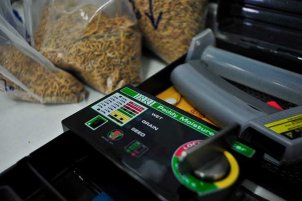Moisture content, as we define it, is the weight of water in rice or paddy expressed in percentage. In post-harvest handling, MC is stated on a wet basis (MCwb). Simply put, it’s percentage of water in a wet grain.
The importance of measuring moisture content
It’s imperative to determine accurate moisture content. This is done with a view to effectively manage and market paddy, for each purpose requires different moisture content.
For e.g. 18% MC for storing grains up-to 2 weeks, 9% for long-term storage, etc.
Inaccurate moisture testing could lead to:
- Grain loss if excessively dried
- Increased drying costs and paddy loss if milled at high moisture content
- Lower head rice, when milled at wrong moisture content
- Weight loss when dried excessively
- Mold development
- Heat buildup in the grain
- Pest infestation
- Discoloration
- Reduced yield
- Loss of germination
How to measure paddy moisture content?
There are two widely used methods to measure moisture content. These are:
1. Primary Method: It is based on weight measurements and is ramified into 2 steps:
– Oven method
– Infrared method
2. Secondary Method: It involves measuring the electrical traits of grains using an electronic instrument
There are a number of different portable moisture meters available in the market. One simply has to make sure that the chosen meter is suitable for harvesting paddy or grains to be milled, depending on whatever you’re planning to do.
Let’s take a look at the moisture content required for different post-production activities:
Paddy Harvesting
When harvesting paddy, one needs to keep in mind that lower moisture content can possibly lead to grain shattering and higher moisture content can lead to losses owing to poor grain quality.
– Ideal moisture content: 20-25%
– Primary losses: Grain shattering and poor quality
Paddy Threshing
– Ideal moisture content: 20% for manual threshing and 20-25% for mechanical threshing
– Primary losses: Breakage/cracking, grain damage and partial threshing
Paddy Drying
The drying process should begin within 24 hours of harvest. Otherwise, there’s a very high possibility of quality deterioration and grain damage.
It should also be noted that seeds should be dried well below 12% moisture content while grains to below 14%.
– Ideal moisture content: 14% or lower
– Primary losses: Discoloration, spoilage and fungal infestation
Rice Storage
– Ideal moisture content:
14% or less if it’s to be milled or stored or a month
Less than 13% for storage up-to 12 months
12% for seed storage
– Primary losses: Pest infestation, fungal infection, loss of germination, etc.
Rice Milling
– Ideal moisture content: 13-14%
– Primary losses: Cracking and breakage
I sincerely hope this post would be helpful to all those planning to venture into the business of rice processing and milling. For any further assistance, feel free to contact Nextech Agri Solutions, one of the best Rice Mill Consultants in India.
 MAIL US :
MAIL US :
 CALL US :
>
CALL US :
>
